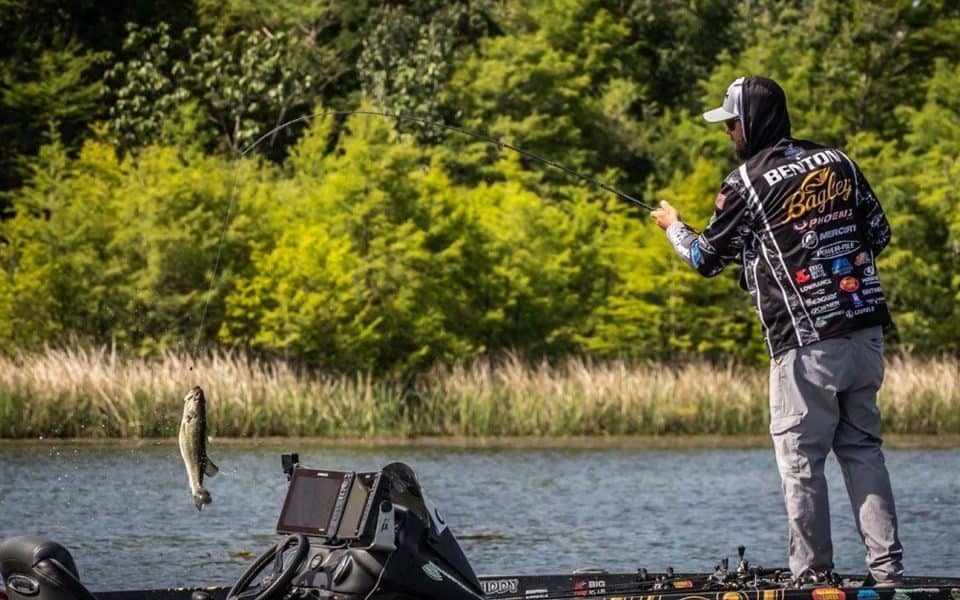Editor’s Note: Mossy Oak Fishing Pro Drew Benton of Panama City, Florida, has been a tournament bass pro for 11 years. In April, 2023, he won the Bassmaster Elite tournament on Lake Murray in South Carolina and pocketed a check for $100,000. In the 2023 Bassmaster Classic, Benton won 4th place and took home $35,000.
Fish on Bad Weather Days
A key to bass fishing consistency is to fish on the days when you may not see anyone else, due to bad weather. One of the worst conditions that tournament anglers have to fish is windy, rainy days. The wind causes baitfish to start moving and pushes them into the pockets and creeks. The wind and the rain also make water move and create a current. Most bass fishermen see the rain and the wind as hindrances and factors that make their bass fishing uncomfortable. But, if you view the wind as your friend and the effect that it has on baitfish and bass as positive, then you can catch bass in the rain or the wind.
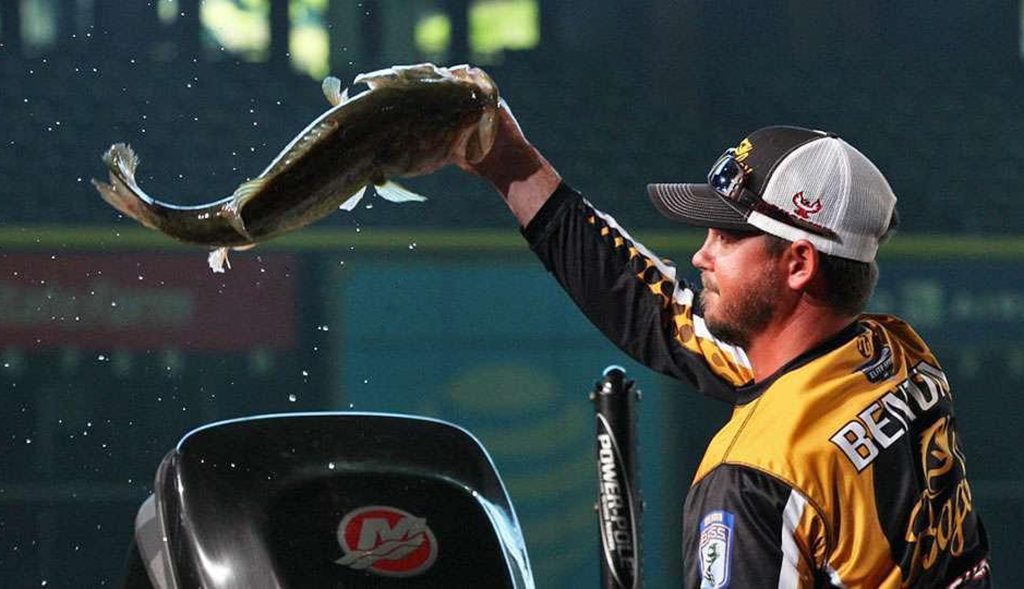
John Phillips
If I’m looking for wind to create current for me, I’ll be searching in places where the wind creates the most current. For instance, if the wind’s blowing, I’ll be fishing around bridges, culverts and points on rivers and lakes and looking for birds to be diving in pockets where the wind has pushed the baitfish into shallow water. I usually will locate bass in that same area, since they’ll feed heavily on those big schools of bait. Under these conditions, I like to fish Bagley rattle baits like a Sunny B, or chatter baits.
Learn Baits You Fish Best Anywhere, Anytime
For me, those baits will start with a jig because it’s so versatile that you can fish it 1 to 40-feet deep. Next, I’ll fish a Bagley’s Pro Sunny B Squarebill balsa wood crankbait in a B1 or a B2 size. Then, I’ll fish some type of top water bait like a Bagley’s Pro Sunny Twin Stem, a walker bait, a buzzbait or a Reflex buzzbait made by Nichols Lures. I’ll fish a swimbait in very-clear water too, since I believe it catches bass better than any other style of bait in this kind of water.
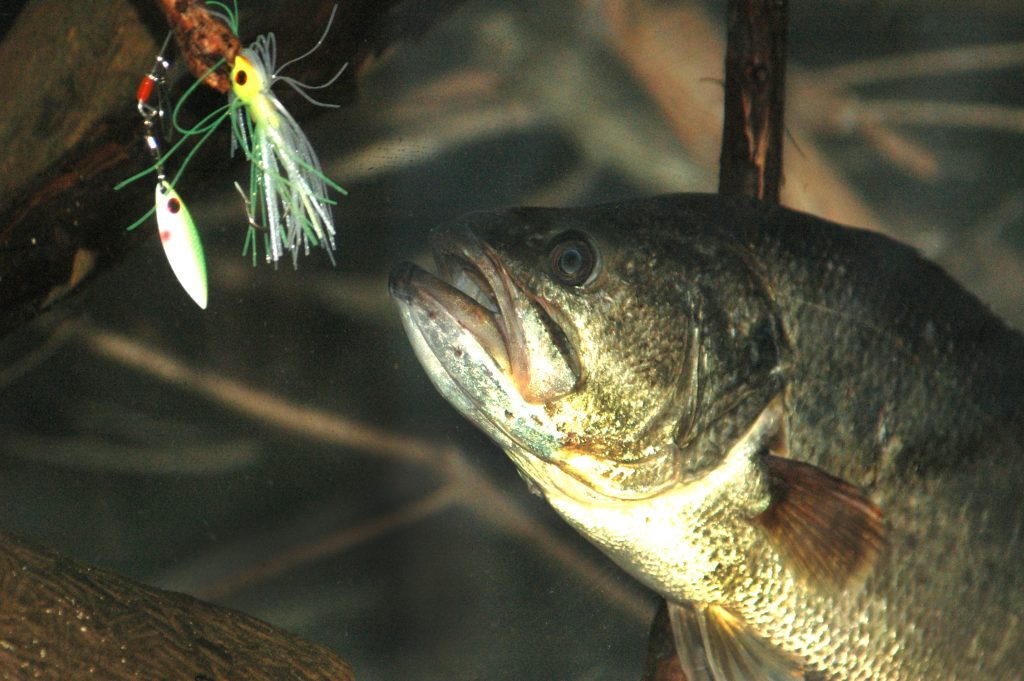
John Phillips
However, my favorite go-to bait is a 7 to10-inch plastic worm. If I can’t get a bite, I’m convinced I can pick up a plastic worm and catch a bass. If the water’s clear, I prefer the green-pumpkin color. If I’m fishing in Florida, I’ll be fishing with a Junebug-colored worm.
Know How to Research New Water
First, I want to know what type of forage there is for bass in a lake or a river. Do the bass feed on shad, blueback herring, bluegills, crawfish or other types of bait in the fall? Tons of different ways to research a lake or a river are available today, with the internet. I’ll usually start by studying Google Maps on my computer or my cell phone. I can see for instance, where the grass grows, where it tops out, and where humps or ridges are. I’ll learn if the lake’s clear too. I also can identify river channels, creek channels, stumps and flats.
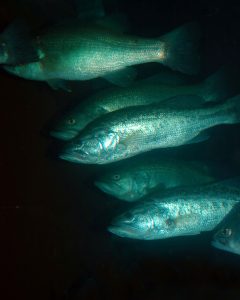
John Phillips
Fall Bass Fishing in Ponds
Ponds are the first waterways to cool down and where the bass turn-on and start feeding heavily in the fall, as the weather triggers bass activity. But, having said that, a fine line exists between great fall bassing and terrible bass fishing. When and how the water in a pond cools down determines when the bass will start feeding actively to put on weight for the upcoming winter months. So, always pay attention to the nighttime temperatures. When the temperature at night cools down the pond’s water where you’re fishing, that’s when you need to be on the water catching those actively feeding bass. They’ll start actively feeding quicker in a pond than the bass in a big lake like Pickwick will.
How to Pick Lures for Pond Bass fishing
Lure selection to catch fall bass depends on what the bass are feeding on at that time in that specific pond.
Choose Lures in Shad, Shiner or Bluegill Colors
If you’ve stocked shad in your ponds, the bass may be feeding on those shad or perhaps bluegills. If the bass are feeding on bluegills, then a bladed jig in either black-and-blue or pumpkin colors will work. When they’re feeding on shiners, I’ll throw a shiner color. If they’re feeding on shad, the color usually will be a white or a shad color.
Fish Baits That Move Often
To catch pond bass, fish baits that move a lot in the fall. I’ll try to get a reaction bite on weighted jigs, swimbaits and crankbaits – particularly in a grassy pond. I’ll be fishing 20-pound test Seaguar Invizx.
Use Crankbaits in Rocky Cover
If the pond has wood or rocky cover, then I’ll fish a crankbait. If the bass aren’t active or feeding, I’ll use a subtle crankbait like Bagley’s Sunny B – a flat-sided, small crankbait that runs about 6 feet deep. You can run this crankbait through shallow water. I’ll be using 15-pound Seaguar Invizx line. If the bass are biting some better, I prefer to fish a crankbait with more erratic action like the Pro Sunny B Squarebill crankbait. This lure is somewhat bigger than the Sunny B, has a tighter wobble and deflects well when it hits cover.
Fish Texas-Rigged Worms and Creature Baits
If I only can fish one lure in a pond during the fall of the year, the Texas-rigged plastic worm is my lure of choice. The worm will catch bass in any pond in any section of the country. Also, it’s really simple and easy to fish – especially for people who don’t know how to fish different lures. If I’m having a bad day of fishing and not getting very many bites, I can take a Texas-rigged worm and start catching bass.
Another key to fishing the plastic worm successfully is to use the lightest weight possible in front of that worm. If I’m fishing in super shallow water, my weight will be 1 ⁄ 8-ounce. If the day’s windy, I may have to use a 3/16-ounce weight. I like a wide-gap hook, depending on the size worm I’m fishing.
My favorite worm is the Big Bite Tour Swim Worm, a paddle-tail worm that comes in two different sizes. If the bass are biting really well, I’ll fish the larger worm. If the bite’s slow, I’ll use the smaller worm. This worm’s paddle tail has more thump to it than a ribbontail does. You can fish this worm like you traditionally fish a worm on the bottom and bump it along. You also can cast it out and swim the worm back to the pond’s bank or the boat. The worm comes through grass easily and is really versatile. My favorite colors in the fall are tilapia, green pumpkin and black and blue.
Fall Bass Fishing in Rivers
Although rivers tend to have more crawfish than ponds do, fall bass will feed on crawfish and shad.
Crankbaits, Spinner Baits and Buzzbaits
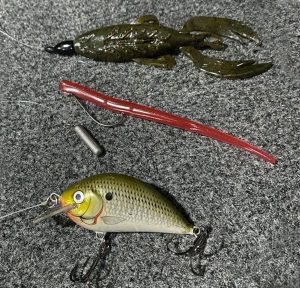
John Phillips
I’ll fish the same two crankbaits that I’ll fish in a pond: The Sunny B Pro and the Sunny B Twin Spin. I’ll also fish a spinner bait in either salt, white or solid white through a tree laying in the water. I won’t get hung-up as much fishing a spinner bait as other lures. The big blade on the spinner bait will be willow leaf. If the water’s clear, those blades will be silver. In stained waters, I’ll fish gold.
A white buzzbait is also a good lure choice in rivers in the fall, since you can cover plenty of water with that lure in a short time. I look for bass behind cover, and that’s where I’ll fish a buzzbait.
Other Lures
I’ll have other lures handy – a jig, a creature bait and a Big Bite Fighting Frog, rigged Texas style, especially if the current’s strong. I’ll be using 20-pound test Invizx line with the frog, a 3/8-ounce weight and a 4/0 worm hook. Although this lure is called a frog, it looks like a bait fish and/or a crawfish.
My jig will be either a Berkley Finesse jig or a Nichols jig in 3/8- or 1/2-ounce. The fall colors I like are green pumpkin or green pumpkin/brown with some orange. I’ll have a Big Bite jig trailer on the back of the jig, and I’ll dye the pincers orange.
Lures on Deep River Ledges Without Grass
I’ll use four different lures when I’m fishing deep-river ledges without grass like you see on the Tennessee River in the fall. Generally, when I’m river ledge fishing, I’ll catch my bass in water 12 to 15 feet deep.
I’ll also fish a deep-diving crankbait, a Nichols Lures’ Ben Parker Magnum Spoon, a dropshot worm or a swimbait like a Big Bite Suicide Shad.
When I find a school of bass holding on a ledge, the first lure I’ll throw to them is a crankbait that’ll dive to the depth where they’re holding. If I don’t catch a bass, then I assume that school may be dormant and not feeding. So, the next lure I’ll throw to them will be the spoon, because a spoon has the ability to fire-up a school of bass and cause them to start feeding actively. The next lure I’ll cast to them will be a 10-inch worm that I’ll fish slowly. If the bass won’t hit the big worm, then I’ll cast a dropshot rig.
When fishing a spoon, I let the lake and the ledge dictate what size and color of spoon I’ll be fishing. For example, on the Tennessee River, the Nichols Lures’ Ben Parker Magnum 8-inch Spoon is king for ledge fishing. If I’m fishing lakes like Eufaula or Seminole, where giant gizzard shad don’t live there like they do on the Tennessee River, I’ll fish a 6-inch Ben Parker Mini Magnum Spoon or a 4-3/4 inch Nichols spoon called the Lake Fork spoon. My favorite colors of spoons will be chrome on one side and a painted shad color on the other because this two-sided color spoon breaks-up the flash of the chrome with the color of a shad, as that spoon wobbles, falling toward the bottom. I fish all the spoons on Seaguar’s Invizx 20-pound-fluorocarbon test line.
While fishing spoons in fall rivers, I’ll cast the spoon out and feed it line as it falls in a straight vertical drop all the way to the bottom. When the spoon hits the bottom, I’ll jerk it up and let it flutter back to almost the same place where it hit the bottom previously. I’ll continue this pattern. When fishing a spoon, you’ve got to be a line watcher, since generally bass will take the bait as it falls back to the bottom. I’ve caught bass in water as deep as 20-feet with this method. If I’m driving around graphing the bottom, and I spot a big school of fish, I can drop a spoon on top of them and catch whatever kind of fish is in that school.
To set the hook after you see a twitch on your line when fishing a spoon, simply reel-up the slack in your line, set the hook, and reel in the bass. If you’re fishing a Nichols Ben Parker Magnum Spoon or a Mini Magnum Spoon, once you’ve hooked a bass, you must keep it coming to the boat. Every time a bass jumps, it has a good chance of throwing the spoon that’s flouncing around in their mouth. I try and swing the bass into the boat as fast as I can after I hook one.
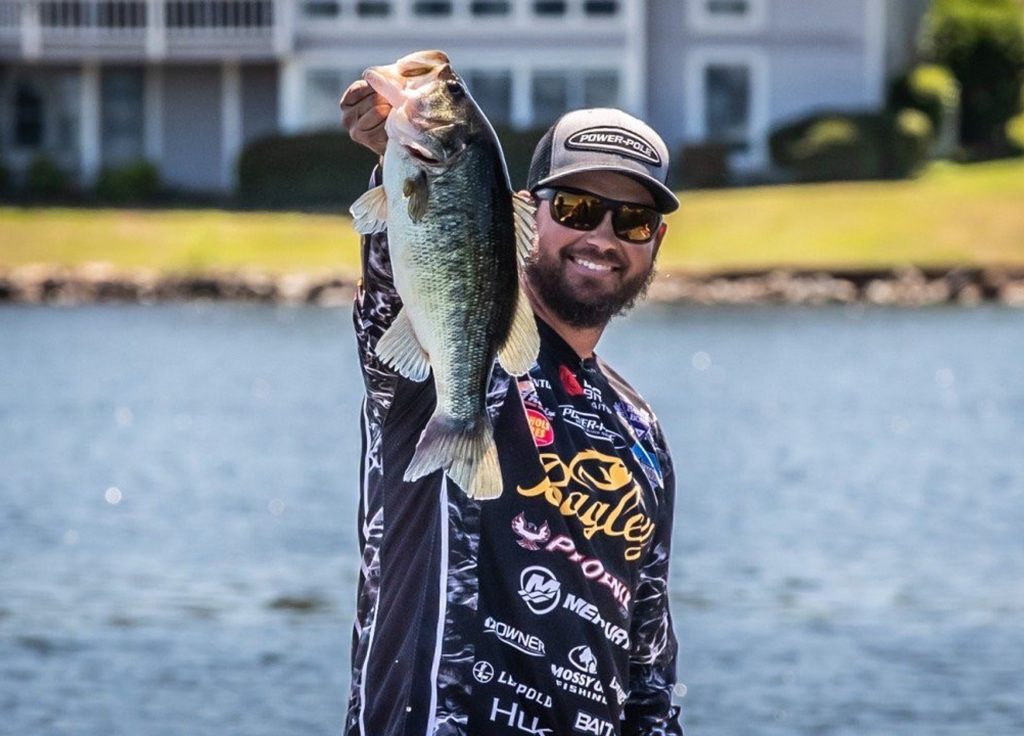
John Phillips
Fall Bass Fishing in Major Impoundments
The key to catching bass in the fall on major impoundments is to find schools of shad with your depth finder. I’ll look for those schools in the mouths of major creeks. The shad will be moving from deep water into the creeks then. Usually, the bass will try to intercept the shad out in the mouths of the creeks. As the shad move closer to the banks, I’ll use my depth finder to find them again – primarily with my side-scanning feature.
However, I use my forward-facing sonar sometimes, too. I also like my Lowrance ActiveTarget Live Sonar when the shad are suspended and not related to cover. You can see your lure sinking and also learn if any bass are hitting it. If the bass aren’t attacking your lure, then you know you need to change lures. If a bass attacks the bait and doesn’t get it in its mouth, I may return to that same spot later in the day and use that same lure, maybe in a smaller size.
This technique is especially effective when you’re sweeping underwater brush piles in lakes. A bass that’s set up beneath an underwater brush pile, usually lives there, until colder weather causes it to move out into deeper water. That’s an advantage to fishing major impoundments. If a bass is holding on a brush pile and attacks your lure but doesn’t eat it, you can wait an hour or more to return to that same brush pile, and cast that same lure. The odds are in your favor to catch that bass.
Fall is a productive time of year to fish for bass. These lures and techniques I’ve suggested have really paid off for me in both good numbers of bass and big bass. I’ve found that bass are extremely aggressive most days in the fall, which makes them easier to catch.

